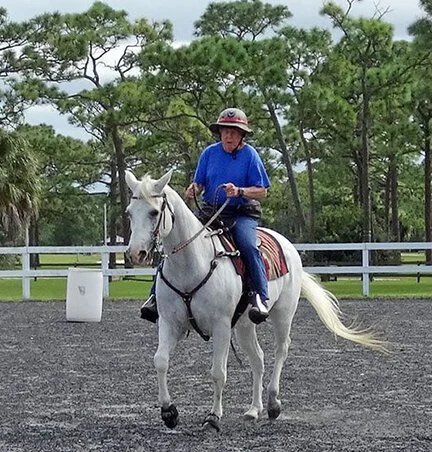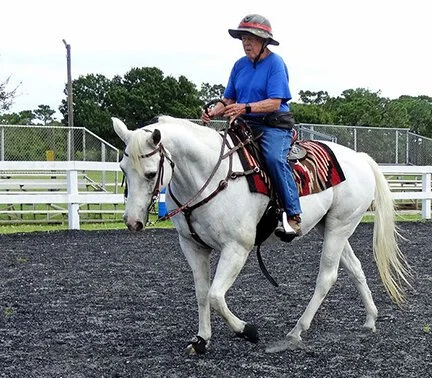John White’s Review Of The Colin Fox Saddle
John White riding his horse in his new Colin Fox saddle. John rated the saddle an “A+” after he stayed in the seat when his fresh horse gave a few “crow hops.”
On the fit, John reported: “Saddle does not rock in either direction, and feels like you could mount without a cinch.”
“After a ride, no dry spots, sweat pattern was full and even.
Thanks so much Colin !”
To shop the Colin Fox saddle click HERE
BUT John White is not a man to be condensed. He took our request for saddle evaluation very seriously, and this is his first report:
First impressions of Australian Saddle. Colin Fox model purchased from Colin Dangaard Inc. Colin has been very helpful in making selections and providing advice for getting started. Much more comfortable than my western saddles, and seat is very secure. Materials and construction are very high quality. Sara tested security by giving me crow hops when I asked for canter, but I think it was her typical urge to gallop as opposed to discomfort with the saddle. The saddle weighs 19 lb., and is very easy to handle. These saddles can be fitted with a horn, but are not built for roping. I opted for a monkey grip, which is quite useful when handling the saddle. Sara seemed to like it, but more time in the saddle and out on trail will be required to determine. My initial evaluation: 5 out of 5 stars. Still experimenting with pad. Saddle was adjusted to fit withers tracings I supplied, and the fleece underside is a nice thickness. It probably really only needs a minimal pad for protection of the saddle surface. The Navajo blanket shown is fairly heavy, 100% wool and may suffice.
The stirrups are safety stirrups designed to be very difficult to hang a boot in, and Australian saddles in general are constructed to release the fender in the unlikely event of a rider being dragged. The tackaberry girth system is very handy for saddling up and releasing. I also like the breastplate design, which is geared for rough terrain or abrupt turns. The poleys will keep the rider from going over the pommel except in extreme events. The Australian stock saddle designs have evolved from over 100 years of cattle herding in rough country in Australia. In recent years, many of them have incorporated some western saddle features, such as this one.
If Sara likes this saddle as much as I do, it is going to be a real solid winner. The saddle puts a lot less stress on my old bones and joints. I believe it will be more comfortable for Sara as well.
UT JOHN WASN’T DONE.
After he’d had a chance to ride in the saddle a few more days he gave this further detailed evaluation:
More on Australian Saddle. Checked saddle fit with an old el cheapo 1/2" thick felt pad. Colin Dangaard recommends no thicker than 1/2" pad for this custom fit saddle. Note that with the custom fit and quality fleece on the underside of the saddle, it probably could be ridden with no pad. That goes against the grain with me. With the 1/2" felt pad, saddle is in good contact all around and pressure qualitatively feels fairly uniform. Sara seemed comfortable with it, and did very nicely with walk, trot, and canter. Here are the things I like about the saddle in addition to overall quality of materials and construction:
Rider position and balance - Sterling. It just "fits to a T". Comfortable for seat, hips, knees, and feet. Easy to ride at walk, trot, and canter. Easy to completely sit the trot, or light posting at a fast trot. Canter position seems to be just right.
Stirrups - The standard safety stirrups are very well designed. Easy to put foot in, and would be almost impossible to hang a foot in. While they release very easily when dismounting, their form and tread make it super easy to maintain proper contact at the toes, and the stirrup shape makes it natural to keep heels down.
Seat comfort - Seat is suspended by webbing. There is no need for any padding, and the seat contour prevents slipping and sliding. No need for roughout or suede, with the maintenance difficulties, for firm seat position.
Tackaberry girthing system - cinching and uncinching are super easy and fast. See Colin Dangaard website for information. The centerfire rigging makes for excellent saddle stability. With the combination of saddle fit and rigging, you don't have to do much more than take the slack out of the cinch. This system originated long ago on western saddles, and Colin revived it for the Aussie saddle. I didn't know if I liked the looks of it in photos or not, but I really like it in practice.
Ease of tacking up - This saddle weighs 19 lb., and with the monkey trip, it is super easy to gently place the saddle on the horse's back. Even for a shorty like me. No more aiming and slinging a 40 lb. ranch saddle with a big slinging heave and thud! When the saddle is in position, you just pull the girth up over the tackaberry buckle, and easily pull the nylon latigo. Quick, easy, and secure. And when I am finished, lifting the saddle to the top saddle rack is just about effortless, thanks to the light weight, monkey grip, and attachment feature on the back of the cantle.
What about no horn? - Western riders often feel there is nothing in front of them when they ride an English saddle. I am finding the saddle contour and the poleys much superior to the western swells and A-fork pommel with horn in terms of forward security. There are plenty of attach points for bags and water bottles. You don't need a horn for stability on this saddle unless you are riding a cutting horse. I ordered a monkey grip with mine, and that provides excellent purchase for mounting and dismounting.
My summary so far - 5 stars for the horse, 5 stars for the rider.
AND COLIN DANGAARD GIVES JOHN WHITE THE 5 STAR AWARD FOR BEST MOST THOROUGH AND HELPFUL TESTIMONIAL AND SADDLE EVALUATION EVER.




